Adolf Loos Early table clock circa 1900 Copper-plated brass, brass, steel, beveled crystal. 21 3/8 x 16 1/4 x 10 1/4 in. (54.3 x 41.3 x 26 cm) Case probably produced by Johannes Heeg, Vienna. Reverse of face painted later with 15.12.911. Together with its double-end case and clock key.
Provenance House of Decorative Arts, London Courtney Ross-Holst, New York Acquired from the above by the present owner, 2004 Exhibited "Wien um 1900: Klimt, Schiele und ihre Zeit," Sezon Museum of Modern Art, Tokyo, 1989 "Adolf Loos," Graphische Sammlung Albertina, Vienna, December 2, 1989-February 25, 1990 Literature ILLUSTRATED Wien um 1900: Klimt, Schiele und ihre Zeit, exh. cat., Sezon Museum of Modern Art, Tokyo, 1989, p. 399, cat. no. 577 Burkhardt Rukschio, ed., Adolf Loos exh. cat., Graphische Sammlung Albertina, Wien, 1989, p. 464, fig. 292 RELATED EXAMPLES Burkhardt Rukschcio and Roland Schachel, Adolf Loos Leben und Werk, Vienna, 1982, pp. 44, 45 Siegfried Wichmann, Jugendstil Art Nouveau: Floral and Functional Forms, Boston, 1984, p. 187 Torsten Bröhan and Thomas Berg, Design Classics 1890-1930, Cologne, 2001, p. 42 Renée Price, ed., New Worlds: German and Austrian Art 1890-1940, New York, 2001, p. 422 Catalogue Essay Phillips would like to thank Dr. Paul Asenbaum and Dr. Burkhardt Rukschcio for their assistance cataloguing the present lot. LOOS AND HIS CLOCKS The great Austrian architect Adolf Loos was fanatical about accuracy and precision. In his most celebrated work, Vienna’s multi-purpose Goldman & Salatsch Building (1909-10), he meticulously calculated every visible detail, as seen on his sketches for the commission. He celebrated economy—of materials, of labor, and of time. Nothing should be wasted, he believed, especially natural products. At the turn of the century, Loos designed buildings which today remain aesthetically advanced models of durability. He was most proud when a client later sent him unsolicited payment in thanks for having designed an apartment that continued to serve so well after twenty-years of use. This act of gratitude, a welcome relief during the lean years spent in Paris (1924-27), vindicated his philosophy. In service to hygiene and to precision, major preoccupations of his, Loos often installed two standard pieces of equipment in his commissions: a handwashing facility near the entrance (at a time when Viennese apartments rarely employed running water) and one or more clocks, wherever they were needed. Watches and clocks of course were widely used at the time. Loos most often installed the latter in the common areas of a building, in keeping with tradition. He first did so in 1897 for the Austrian imperial tailor Ernst Ebenstein, whose haberdashery was located on the prestigious Kohlmarkt in central Vienna. Loos’s first table clock enjoyed pride of place in the public entrance to his first architectural commission. Shortly thereafter he added a longcase floor clock to his repertoire and later, at Goldman & Salatsch, a system of electric clocks noted for telling time simultaneously and for not needing to be wound. Well known is Loos’s imposing railway-station clock, which, after the building’s 1990 renovation, returned to its traditional position above the main stairs and which displays equal time in four directions. Loos installed a similar instrument for the Strasser family (1918-19), a conventional high-precision pendulum clock that directs electric impulses to satellite clocks throughout the house, the best known of which was an octogonal example on the wardrobe wall near the washbasin at the main entrance. The elaborate Strasser house installation was an exception, however, as Loos usually equipped houses and apartments with single table clocks or his floor clocks. A common characteristic distinguishes Loos’s known clocks; they comprise a metal case and crystal glazing on all sides. The dial door of each hinges on the right and closes with a key inserted over a square stud (the sole exception being the early Ebenstein clock). All of these instruments stand on crystal-shaped feet, although one known example has ball feet, a later alteration perhaps. Loos’s clocks are fitted with a pendulum movement fixed to the rear glass by three to five bolts according to type (five in the c
Adolf Loos Early table clock circa 1900 Copper-plated brass, brass, steel, beveled crystal. 21 3/8 x 16 1/4 x 10 1/4 in. (54.3 x 41.3 x 26 cm) Case probably produced by Johannes Heeg, Vienna. Reverse of face painted later with 15.12.911. Together with its double-end case and clock key.
Provenance House of Decorative Arts, London Courtney Ross-Holst, New York Acquired from the above by the present owner, 2004 Exhibited "Wien um 1900: Klimt, Schiele und ihre Zeit," Sezon Museum of Modern Art, Tokyo, 1989 "Adolf Loos," Graphische Sammlung Albertina, Vienna, December 2, 1989-February 25, 1990 Literature ILLUSTRATED Wien um 1900: Klimt, Schiele und ihre Zeit, exh. cat., Sezon Museum of Modern Art, Tokyo, 1989, p. 399, cat. no. 577 Burkhardt Rukschio, ed., Adolf Loos exh. cat., Graphische Sammlung Albertina, Wien, 1989, p. 464, fig. 292 RELATED EXAMPLES Burkhardt Rukschcio and Roland Schachel, Adolf Loos Leben und Werk, Vienna, 1982, pp. 44, 45 Siegfried Wichmann, Jugendstil Art Nouveau: Floral and Functional Forms, Boston, 1984, p. 187 Torsten Bröhan and Thomas Berg, Design Classics 1890-1930, Cologne, 2001, p. 42 Renée Price, ed., New Worlds: German and Austrian Art 1890-1940, New York, 2001, p. 422 Catalogue Essay Phillips would like to thank Dr. Paul Asenbaum and Dr. Burkhardt Rukschcio for their assistance cataloguing the present lot. LOOS AND HIS CLOCKS The great Austrian architect Adolf Loos was fanatical about accuracy and precision. In his most celebrated work, Vienna’s multi-purpose Goldman & Salatsch Building (1909-10), he meticulously calculated every visible detail, as seen on his sketches for the commission. He celebrated economy—of materials, of labor, and of time. Nothing should be wasted, he believed, especially natural products. At the turn of the century, Loos designed buildings which today remain aesthetically advanced models of durability. He was most proud when a client later sent him unsolicited payment in thanks for having designed an apartment that continued to serve so well after twenty-years of use. This act of gratitude, a welcome relief during the lean years spent in Paris (1924-27), vindicated his philosophy. In service to hygiene and to precision, major preoccupations of his, Loos often installed two standard pieces of equipment in his commissions: a handwashing facility near the entrance (at a time when Viennese apartments rarely employed running water) and one or more clocks, wherever they were needed. Watches and clocks of course were widely used at the time. Loos most often installed the latter in the common areas of a building, in keeping with tradition. He first did so in 1897 for the Austrian imperial tailor Ernst Ebenstein, whose haberdashery was located on the prestigious Kohlmarkt in central Vienna. Loos’s first table clock enjoyed pride of place in the public entrance to his first architectural commission. Shortly thereafter he added a longcase floor clock to his repertoire and later, at Goldman & Salatsch, a system of electric clocks noted for telling time simultaneously and for not needing to be wound. Well known is Loos’s imposing railway-station clock, which, after the building’s 1990 renovation, returned to its traditional position above the main stairs and which displays equal time in four directions. Loos installed a similar instrument for the Strasser family (1918-19), a conventional high-precision pendulum clock that directs electric impulses to satellite clocks throughout the house, the best known of which was an octogonal example on the wardrobe wall near the washbasin at the main entrance. The elaborate Strasser house installation was an exception, however, as Loos usually equipped houses and apartments with single table clocks or his floor clocks. A common characteristic distinguishes Loos’s known clocks; they comprise a metal case and crystal glazing on all sides. The dial door of each hinges on the right and closes with a key inserted over a square stud (the sole exception being the early Ebenstein clock). All of these instruments stand on crystal-shaped feet, although one known example has ball feet, a later alteration perhaps. Loos’s clocks are fitted with a pendulum movement fixed to the rear glass by three to five bolts according to type (five in the c

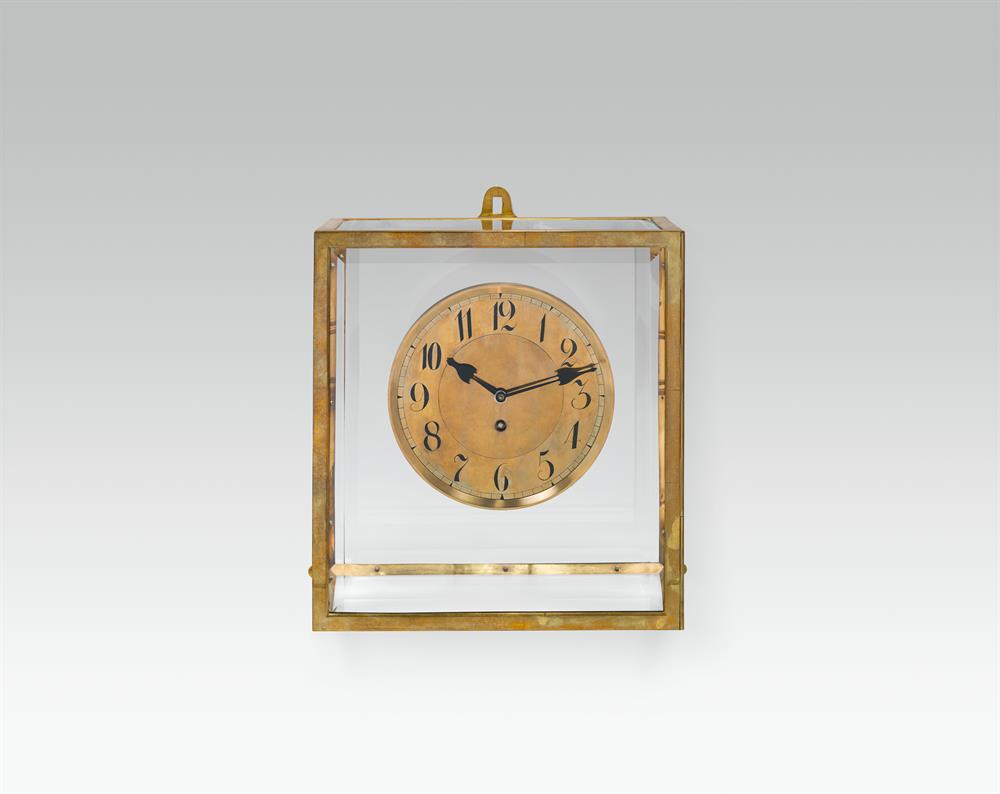

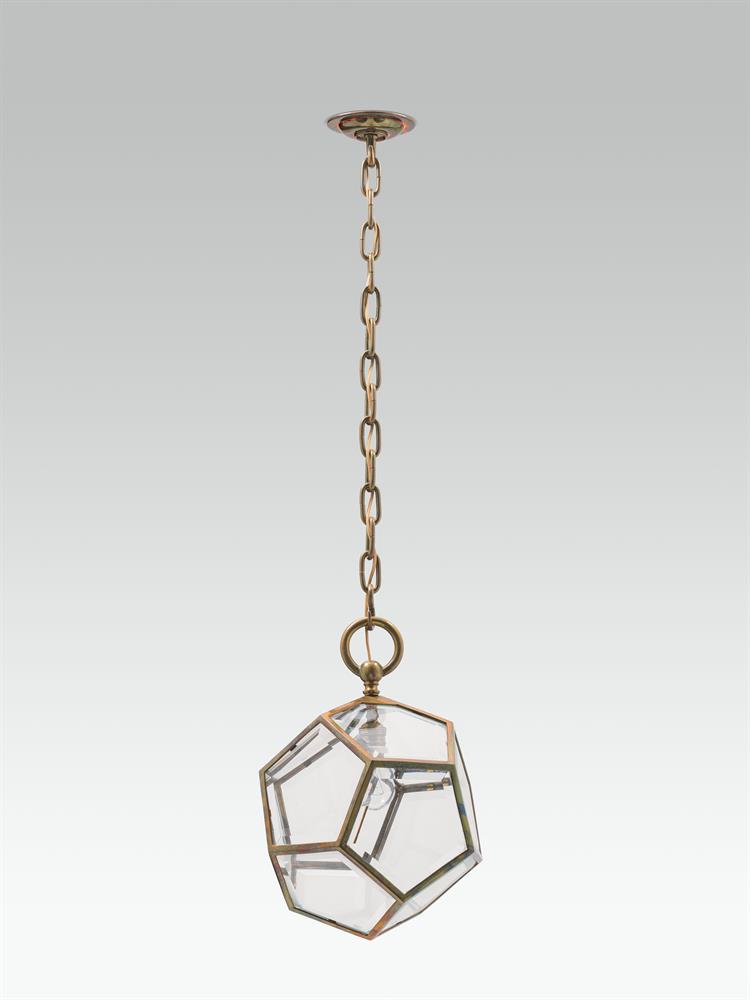


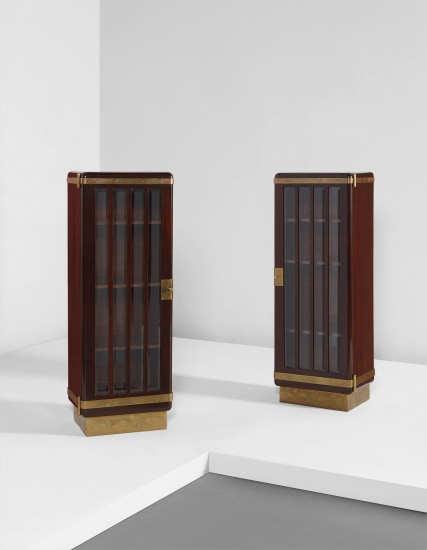



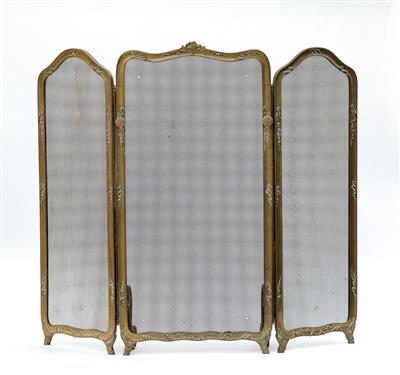
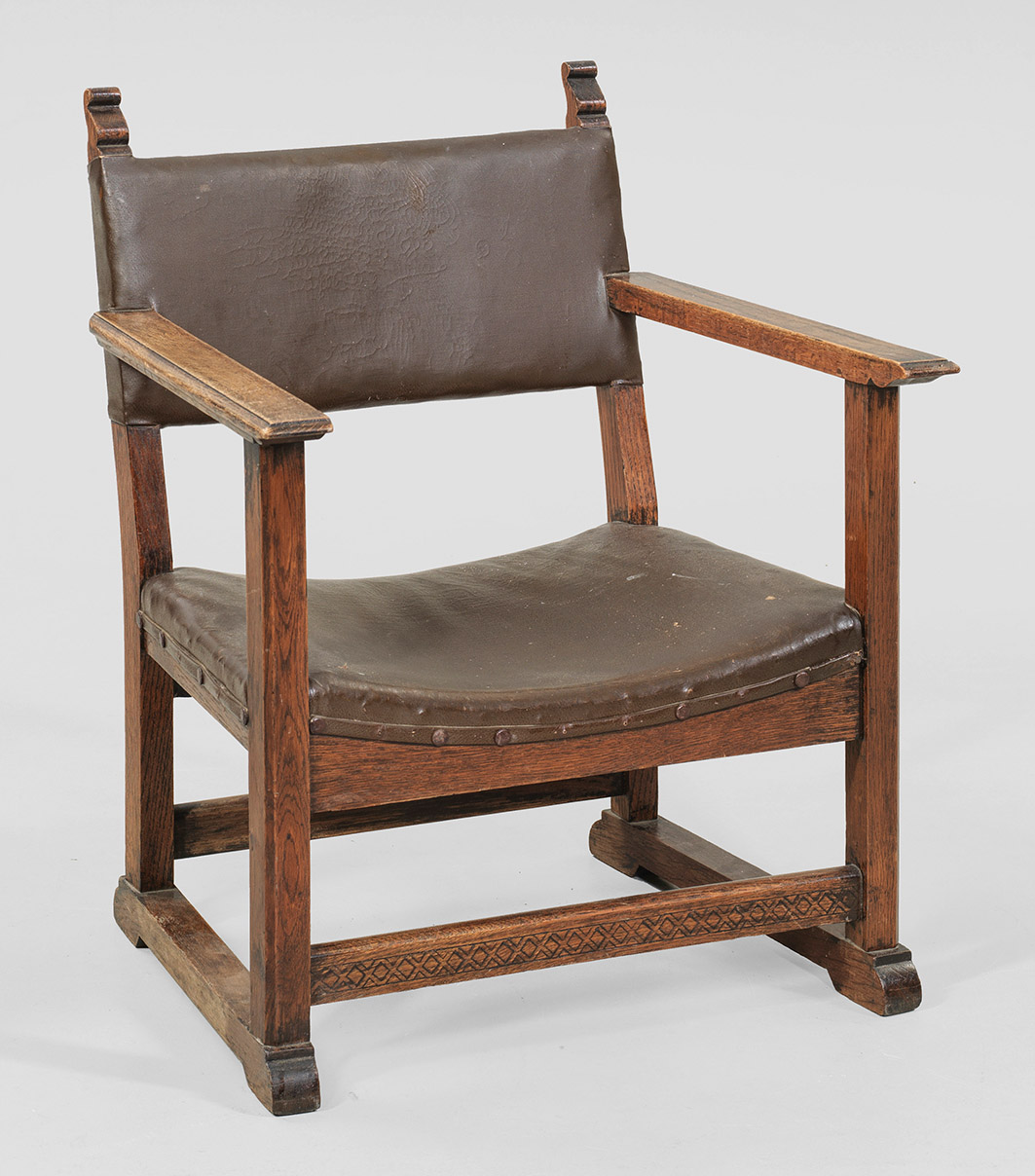

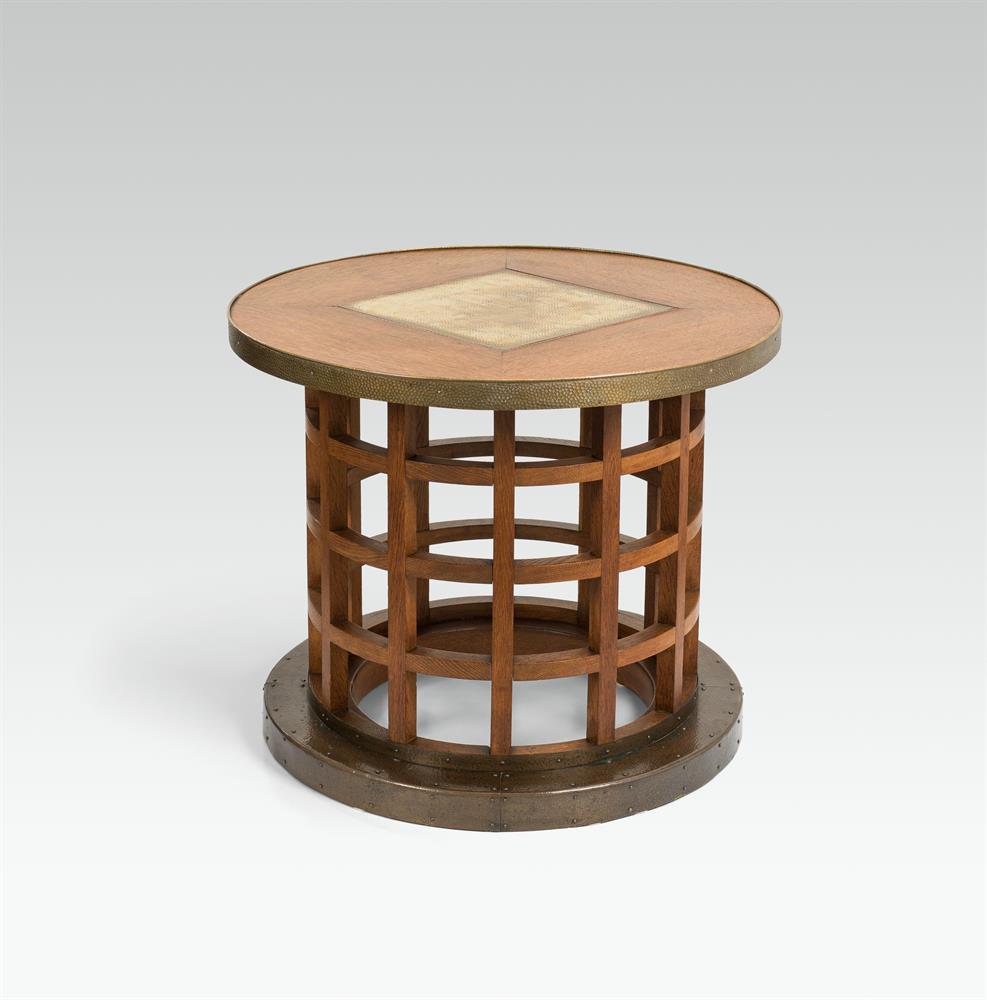
Try LotSearch and its premium features for 7 days - without any costs!
Be notified automatically about new items in upcoming auctions.
Create an alert